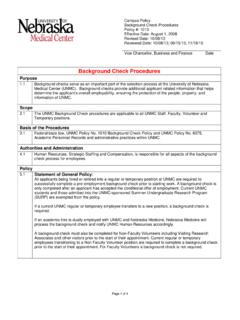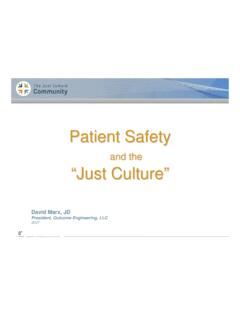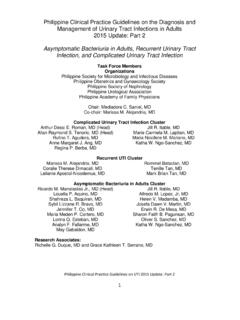Transcription of Urinary Tract Infection and Asymptomatic Bacteriuria Guidance
1 Urinary Tract Infection and Asymptomatic Bacteriuria Guidance Urinary Tract Infection (UTI) is the most common indication for antimicrobial use in hospitals and a significant proportion of this use is inappropriate or unnecessary. The Antimicrobial Stewardship Program at the Nebraska Medical Center has developed guidelines to facilitate the evaluation and treatment of UTIs. Ordering of Urine Culture: Urine cultures should only be obtained when a significant suspicion for a UTI exists based on patient symptoms. Urine culture data should always be interpreted taking into account the results of the urinalysis and patient symptoms. In the urinalysis the presence of leukocyte esterase suggests WBC will be present while nitrites suggest that gram-negative organisms are present. Neither of these findings is diagnostic of a UTI. Indication for urine culture: When signs or symptoms suggest a Urinary Tract Infection is present (see below) In patients who cannot provide history (intubated, demented) and have sepsis without anothersource to explain itUrine culture NOT recommended: Change in urine color, odor, or turbidity these are typically due to patient hydration and notindicators of Infection Patient lacks symptoms of UTI Automatically in workup of fever or sepsis patients who can provide a history should not havea urine culture obtained as part of fever evaluation unless symptoms suggest a UTI is present Pre-operatively except in urologic surgery where mucosal bleeding is anticipated When a Urinary catheter is placed or changed At admission After treatment of UTI to document cureInterpretation of Urine Culture.
2 Bacteria are frequently noted on urinalysis and cultured from urine specimens. The presence of bacteria in the urine may indicate one of 3 conditions: 1) specimen contamination; 2) Urinary Tract Infection (UTI); or 3) Asymptomatic Bacteriuria (ASBU). When evaluating the clinical significance of a urine culture these 3 conditions must each be considered and classification should be based upon history and exam findings coupled with urine findings. Specimen contamination should always be considered as this is common, particularly in female patients. High numbers of squamous cells on the urinalysis (>20) suggests contamination and results of the culture should generally be ignored. In patients with a positive urine culture, where no contamination exists, clinicians must determine if the patient is exhibiting symptoms of a UTI. Symptoms typical of a UTI are Urinary frequency or urgency, dysuria, new onset hematuria, suprapubic pain, costovertebral tenderness or fever.
3 Patients with a Urinary catheter in place may have more vague symptoms such as new onset or worsening fever, chills, pelvic discomfort, acute hematuria and altered mental status with no other identifiable etiology. It is important to recognize that pyuria is not an indication for treatment. Pyuria is the presence of an increased number of polymorphonuclear leukocytes in the urine (generally >10 WBC/hpf) and is evidence for genitourinary Tract inflammation. Pyuria can be seen in patients with catheter use, sexually transmitted diseases, renal tuberculosis, interstitial nephritis, or ASBU. The absence of pyuria is a strong indicator that a UTI is not present and is useful in ruling out a UTI. Asymptomatic Bacteriuria Patients with positive urine cultures who lack symptoms of a UTI have the diagnosis of Asymptomatic Bacteriuria . ASBU is more common in some patient populations and the prevalence increases with advancing age (Table 1).
4 It is also associated with sexual activity in young women. Patients with impaired Urinary voiding or indwelling Urinary devices have a much higher prevalence of ASBU. Table 1: Prevalence of Asymptomatic Bacteriuria in selected populations Population Prevalence, % Healthy, premenopausal women Pregnant women Postmenopausal women aged 50-70 Diabetic patients Women Men Elderly person in the community ( 70 yrs.) Women Men Elderly person in a long-term care facility Women Men Patients with spinal cord injuries Intermittent catheter use Sphincterotomy and condom catheter in place Patients undergoing hemodialysis Patients with indwelling catheter use Short-term Long-term 25-50 15-40 23-89 57 28 9-23 100 Screening for and treating ASBU patients should only occur if the Bacteriuria has an associated adverse outcome (such as development of a symptomatic Urinary Tract Infection , bacteremia, progression to chronic kidney disease, etc.)
5 That can be prevented by antimicrobial therapy. There are only 2 clinical situations where these criteria are clearly met. Pregnant women should be screened and treated for ASBU, as they have a significantly increased risk of developing pyelonephritis as well as experiencing a premature delivery and delivering a low birth weight infant. Prior to transurethral resection of the prostate (TURP) or any other urologic procedure with a risk of mucosal bleeding, patients should be screened for Bacteriuria , as it has been associated with a major increase in the risk for post-procedure bacteremia and sepsis. Treatment of ASBU in both these situations has been demonstrated to prevent these complications. Unfortunately many patients with ASBU receive treatment which they do not benefit from and in fact are likely harmed by. The unnecessary treatment of ASBU can lead to antibiotic resistance, adverse drug effects, C.
6 Difficile Infection , and contribute unnecessarily to the costs of medical care. Gandhi and colleagues described antibiotic use for 3 months on a single medicine ward with 54% (224/414) of patients treated with antimicrobials and UTI the most common diagnosis (N=49). Of those who were treated for a UTI, had no symptoms suggestive of a UTI. In another study Cope, et al. analyzed 280 catheterized patients at a VA with considered to have ASBU. Thirty-two percent of ASBU patients received treatment (inappropriately) with 3 patients developing a C. difficile Infection . Linares, et al. found 26% of 117 patients with ASBU at his institution were treated inappropriately for an average of days and the treatment resulted in 2 cases of C. difficile Infection and one case of QT prolongation. They then introduced an electronic reminder which did not decrease the incidence of inappropriate treatment (still 26%) but decreased duration of therapy to days and with no antibiotic adverse events noted.
7 Patients at TNMC are not excluded from this inappropriate treatment. An analysis of 68 patients with positive urine cultures on 2 medical wards at TNMC over 3 months in 2011 revealed that 22 ( ) were Asymptomatic using a very liberal definition of symptoms. Antimicrobials were inappropriately prescribed to (8/22) of those with ASBU. This resulted in two patients developing clinically significant diarrhea with one of them being diagnosed with a C. difficile Infection . The take home message is that treatment of ASBU is common and results in significant patient harm. Clinicians should be aware of this when making decisions about the treatment of possible UTI. Who to screen and treat for Asymptomatic Bacteriuria : Pregnant women (at least once in early pregnancy) Patients prior to a urologic procedure for which mucosal bleeding is anticipated ( TURP, etc.)
8 Kidney transplant patients are a group where the data is unclear and no recommendation can be made Who not to screen or treat for Asymptomatic Bacteriuria : Premenopausal, non-pregnant women Diabetic women Older persons living in the community Elderly institutionalized residents of long-term care facilities Spinal cord-injured patients Patients with an indwelling urethral catheter (do not treat Asymptomatic funguria either) Positive Urine Culture Algorithm This algorithm is designed for common clinical situation where the treating clinician is required to interpret urine culture results 24-48 hours after they were obtained by another provider and the clinical situation that prompted the testing is not clear. Positive Urine Culture Definition clean catch specimen with > 105 cfu/ml of 1 bacterial species* Catheterized specimen with > 103 cfu/ml of 1 bacterial species* Evaluate the Urinalysis Contamination (>20 squamous cells/hpf) Disregard if no symptoms of UTI Consider obtaining new specimen if suspicious for UTI exists No Contamination (<20 squamous cells/hpf)
9 Evaluate for ongoing symptoms of UTI Dysuria, frequency, urgency, fever, suprapubic or CVA pain/tenderness, mental status changes/lethargy without another explanation Asymptomatic Bacteriuria Do not treat unless pregnant or impending urologic procedure with bleeding anticipated No symptoms Use Clinical Judgment Lack of pyuria is strong evidence UTI is absent Unclear/Difficult to Determine UTI Treat based on guidelines Symptoms Present *The presence of 3 or more bacterial species in the urine suggests the specimen is contaminated and a new specimen should be obtained if a UTI is suspected Treatment of Urinary Tract Infections in Adults Complicated vs. Uncomplicated UTIs If it is determined that a patient has a Urinary Tract Infection based on symptoms, UA, and urine culture (see algorithm below), a decision must be made on how to treat the Infection .
10 Multiple factors play a role deciding on the most appropriate therapy choice and duration including: type of UTI (complicated or uncomplicated), if concern for pyelonephritis exists, patient allergies, location of patient (hospital, community, or long-term care facility), recent history of UTI or antibiotic exposure, previous Urinary pathogens isolated, and cost of agent to be prescribed. Patients with UTI can generally be seperated into 2 clinical groups: complicated and uncomplicated. A complicated UTI is a UTI in the setting of an underlying condition or factor which increases the risk of treatment failure. Some of these factors include: Male sex Diabetes Pregnancy Symptoms 7 days prior to seeking care Hospital acquired Infection Renal failure Urinary Tract obstruction Presence of an indwelling urethral catheter, stent, nephrostomy tube or Urinary diversion Recent Urinary Tract instrumentation Functional or anatomic abnormality of the Urinary Tract History of Urinary Tract Infection in childhood Renal transplantation Immunosuppression Put another way episodes of acute cystitis occuring in healthy, premenopausal, nonpregnant women with no history suggestive of an Urinary Tract abnormalities are considered uncomplicated Urinary Tract infections and all other UTIs are classified as complicated.












